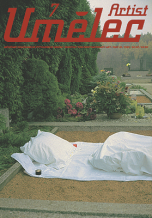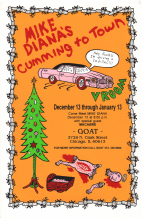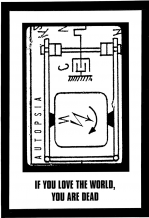| Zeitschrift Umělec 1999/1 >> Longing to Become Americans | Übersicht aller Ausgaben | ||||||||||||
|
|||||||||||||
Longing to Become AmericansZeitschrift Umělec 1999/101.01.1999 Tomáš Pospiszyl | China | en cs |
|||||||||||||
|
In mid-August 1998, a gallerist and curator from New York paid me a visit at the National Gallery in Prague. It was his first time in town and first time in Central and Eastern Europe. His gallery is exclusively focusing on Asian art and he himself is Chinese by origin, born and educated in the United States. I showed him our collection of Czech art (he was not in the least interested in early French modernism, the biggest attraction of the NG’s Modern and Contemporary Art Collection at Veletržní palác, as he could go and see it in Paris). We walked through the exposition from the 60s to the 80s and I was trying to explain to him in manner as brief as possible the course of Czech art’s development, its relations to foreign art, and stories of the individual artists. We then continued through the 80s and 90s, followed by lunch.
„Why are so many Czech artists making their art as if they were Americans?“ he took me by surprise. Prior to the visit at the NG, he spent the whole day walking around the city, experiencing atmosphere of historical architecture. To him, Czech art of the past few decades he saw at the Veletržní palác appeared separated from its own cultural tradition. It would be easier to classify it into the context of American art than art of Gothic cathedrals and Art Nouveau palaces. He maintained that a part of the world is definitely doomed to catastrophe - total Americanization and loss of one’s own cultural identity. The American culture has been facing a peculiar problem in the past - to create a culture sufficiently universal for thousands of cultural groups living at its territory to be able to identify with it. The result is a carefully selected hybrid whose base is insofar universal and general as to be easy for anybody living anywhere in the world to identify with it. I opposed my guest by saying that Czech art is in no way Americanized and that there, indeed, exists a number of quite natural barriers separating Czech and American art. I also claimed that there is a difference between American culture and American business. Hollywood is business, most pop music is business, American television is business. The question thus is whether we involuntarily become Americans by watching Beverly Hills 90210 or whether we become victims of American business. On the other hand, you have William Faulkner, Richard Serra, the Coen brothers, the Residents and others. There is perhaps no other culture that gave the world as many stimuli as Americans during the past 50 years. The New York curator, however, said that this fact may never compensate for the damage done by America to global culture. The situation in Chinese culture, he continued, is completely catastrophic as Chinese artists - whether living in China or in other parts of the world - are cutting the ties with their domestic tradition and work in completely different traditions. Therefore, the exhibition of Chinese painting which was shown in Prague’s Rudolfinum Gallery was an exhibition of American, not Chinese art, he said as he perfectly knew the show’s catalogue and the artists represented. I remembered of this discussion and my disagreement with the arguments presented to me at that time while walking through a gigantic exhibition of contemporary Chinese art in New York, located simultaneously at PS 1 and the Asia Society Gallery. Titled Inside Out, the exhibition included Chinese avant-garde art both from the People’s Republic of China and ex-colonial Hong Kong and Taiwan and work by Chinese artists living in the United States and other parts of the world. China’s cultural tradition is so sovereign and different from that of Europe that it makes difficult for me, an average European, to comprehend it. Do I really have to be a sinologist in order to understand contemporary Chinese art? Many of the works exhibited seemed to bear either perfectly universal message or one very fitting the story of contemporary international art as it has developed during the past 30 years. I got a similar impression from the exhibition of post-war Japanese art Scream Against the Sky which was shown in the New York Guggenheim Museum in 1995. Among other things, it showed how universal modern and avant-garde art is. It seemed that many art trends have evolved in parallel not only in Europe and America, but also in Japan. A hypothetical visitor from outer space familiar with the concept of art but ignorant of its concrete expressions would probably have hard time distinguishing works made by the Gutai group from American or European art of the same period. Or at least it would be incomparably more difficult than distinguishing 19th Century art, whether made in the West or in Japan, from 20th Century art. May we thus speak of some general tradition of modern and contemporary art which is concurrent in all cultures? Is this tradition Americanized then? The Inside Out exhibition was curated by Gao Minglu who was also involved in the well-known show Avant-garde in February 1989. Closed twice during its course, the exhibition presented dozens of contemporary artworks in an official art space. The reason for closing it down for the first time was an artistic act by Xiao Liu who shot at her work - two phone booths with figures inside them. The second time the show was closed down for its overall shocking impression. Gao Minglu is now living abroad and is considered one of the most competent experts in contemporary Chinese art. Inside Out turned out to be as surprising as Scream Against the Sky. Many of the art works could easily be made anywhere in the world. This is not true only for contemporary Chinese painting which is, indeed, following the western taste in a certain way but it is definitely the case of conceptual art which seems to flourish in China. The exhibition was organized in sections that were not defined chronologically or geographically but were based on concepts for western visitors as easy to understand as possible. There was a performance section, a dada-influenced art section, calligraphy, new painting, new development of traditional ink painting, etc. China has been for several centuries influenced by Western art but we may speak of the avant-garde’s infiltration starting at the beginning of the 20th Century only. During the past decades, the Communist regime in China has been oriented both against the West and against the country’s own traditions. Goa Minglu stresses that art presented in Inside Out comes from four very different territories with different traditions and histories, from mainland China, Taiwan, Hong Kong and Chinese expatriots living and working abroad. The other surprising thing for a Czech visitor is that a major number of Chinese artists working abroad do not perceive their emigration to be a tragedy, they even oppose to use the word exile. They simply say they cannot return home and live somewhere else instead. Their shock as they enter environment unknown to them is thus much bigger than shock coming from the fact they cannot return back home or from being far away from home. In the past decade, China has gone through and dealt with all the tendencies of Western art of the past one hundred years. Does this speedy development represent a cultural catastrophe? Do there exist not only common esthetics of modern art but also common tradition of avant-garde art? Or is infiltration of modern art poisonous for local traditions? The answer may not be found anywhere but in the works of art themselves. The nice thing about Chinese art at this exhibition is a fact that it is a natural and authentic response to globalization and commercialization of the world which the Communist regime, too, failed to stop. In 1996, for example, artist Wang Jin organized an event called Ice: Central China. He was commissioned to make work for the occasion of a new shopping mall opening in one of central China’s provinces. Wang Jin then built a long, semicircular wall separating the visitors to the event from the entrance to the department store. The wall was made out of cubes of ice inside which there were various luxury products frozen in the ice, including video cameras, shoes, liquor, etc. It was not quite clear through the thick layer of ice what exactly is inside the individual cube. As the ice started melting and curious hands polished the sides of the cubes, though, their contents was more and more obvious. The visitors, of course, did not wait for the wall to melt completely and pounded it to pieces to get hold of the products and free their way to the shopping mall, their consumer paradise. One may imagine that an artist from America, France, and with good constellation of stars even from the Czech Republic, could do something similar. It is only due to our own limitation that we connect „central China“ exclusively with an image of primitive ink paintings and realistic oil pictures of Communist heroes. Ice: Central China is work with a clear message understood everywhere department stores are build and products are on sale. Perhaps it is not exclusively Chinese art but it is global art referring to a major part of global civilization. Ice: Central China, however, is not a work that the actual cultural heritage would reject. Since 1990s, part of Chinese art has been fighting „mcdonaldization“ of art and perception of art as a mere product. Instead of ideological art, it is commercial art that is perceived as deadly enemy. There exists opposition to Chinese soc-art which is perceived as political and artistic kitsch combining ideological propaganda and consumer lifestyle. This art does not fight for liberation from political oppression. It is conformist and cannot be stamped as avant-garde, says Gao Minglu. Naturally, there is aversion in Chinese art to current political situation in China but the response to materialism is perhaps even stronger. Part of the artists have withdrawn to their small apartments where they are engaged in body art, pseudo-religious meditations and making artworks that are subjects to quick doom. Another part of them started working in public space. As of the mid-80s, Gao Minglu divides Chinese art into several groups. One of the most important of them is rebirth of interest and development of classic ink painting, while another represent new figuration and (soc)popart painting. Chinese conceptual art boasts with its own international star. Xu Bing became famous mainly for his monumental work entitled Book from the Sky. He has worked on this piece for three years to make a long, partly divided and densely inscribed volume. The work includes two thousand different types of script looking like Chines symbols. It is however, elaborate pseudo-language created by the artist not making any sense. In other works, Xu Bing transforms roman characters into Chinese script. After a while, what we consider to be Chinese characters starts to appear as familiar letters and words. Huang Yong Ping is a radical dadaist and conceptualist. Art history, he claims, is nothing but an art war in which critics, curators and historians are mere soldiers fighting with various directions and schools. In one of his works, he threw a book on Chinese art history and a book on Western art history into a washing machine, processed them for two minutes and took the resulting pile of intertwined paper to exhibit it in a gallery. Art created in apartments and other private spaces makes up a whole independent group. Song Dong has been practicing traditional calligraphy for years but he utilizes water instead of ink. The signs made in this method thus exist for a few moments only and then they vaporize. It is just possible to document them on photographs. Qiu Zhijie, on the other hand, wrote a preface to one of Chinese literature’s classical works a thousand times over each other in layers and the resulting work was a sheet of paper completely covered with black ink. Zhang Huan covered himself with honey entirely and sat naked in a public toilet, attracting flies to get stuck to his body. With this work, he wanted to call attention to living and housing situation in China and through physical suffering he realized his body better. Videos projected in the exhibition documented a number of performance works to be made in China. An artist hung at the ceiling was literally bleeding into metal bins on the floor (was the resulting sound the goal of the event?) while other group of artist ploughed a field and inserted coins into the created rows. If there exists a general tradition of avant-garde, it does not have to be necessarily Americanized in a negative sense of the word. Interconnectivity of the world, or globalization if you will, may be an unavoidable sign of our time which will go on further. In the least, the Inside Out exhibition showed that we may speak of a situation in specific countries with specific histories in a way that is generally understandable. It is not easy to evaluate whether it is due to skill of its organizers or whether it really is a feature of contemporary Chinese art. In any case, there are enough works for one to be able to compose a similar exhibition with. In this view, the Czech Republic seems to be further bogging down to locally tampered traditionalism. Would it be possible to put together a big and internationally attractive exhibition of Czech art of the past decade? I fear to answer this question yet it is clear that we will have to make an attempt at such an evaluation in the near future. Will we or not, our relation to contemporary international (or „American“) art and a question whether there is a Czech tradition and to what extent it is able to survive in global competition form the themes that such an exhibition should tackle.
01.01.1999
Empfohlene Artikel
|
|||||||||||||
|
04.02.2020 10:17
Letošní 50. ročník Art Basel přilákal celkem 93 000 návštěvníků a sběratelů z 80 zemí světa. 290 prémiových galerií představilo umělecká díla od počátku 20. století až po současnost. Hlavní sektor přehlídky, tradičně v prvním patře výstavního prostoru, představil 232 předních galerií z celého světa nabízející umění nejvyšší kvality. Veletrh ukázal vzestupný trend prodeje prostřednictvím galerií jak soukromým sbírkám, tak i institucím. Kromě hlavního veletrhu stály za návštěvu i ty přidružené: Volta, Liste a Photo Basel, k tomu doprovodné programy a výstavy v místních institucích, které kvalitou daleko přesahují hranice města tj. Kunsthalle Basel, Kunstmuseum, Tinguely muzeum nebo Fondation Beyeler.
|






























 New book by I.M.Jirous in English at our online bookshop.
New book by I.M.Jirous in English at our online bookshop.
Kommentar
Der Artikel ist bisher nicht kommentiert wordenNeuen Kommentar einfügen